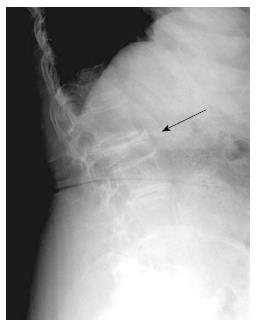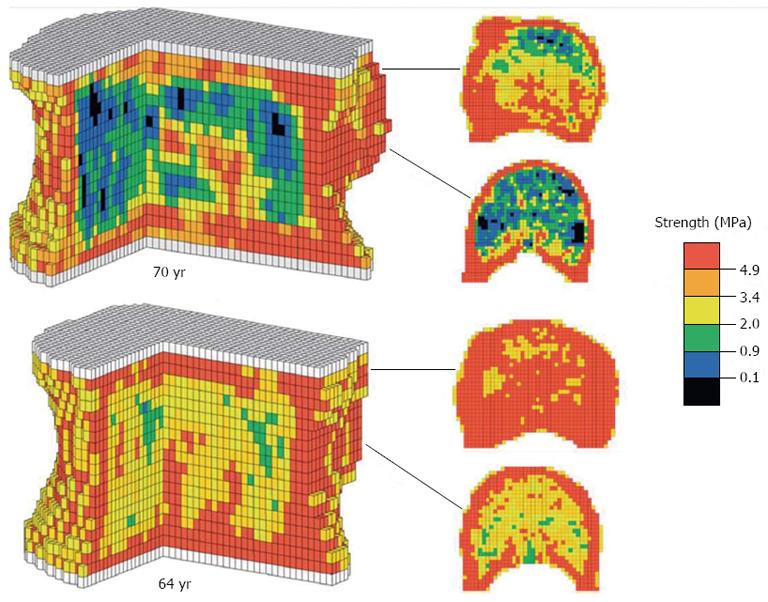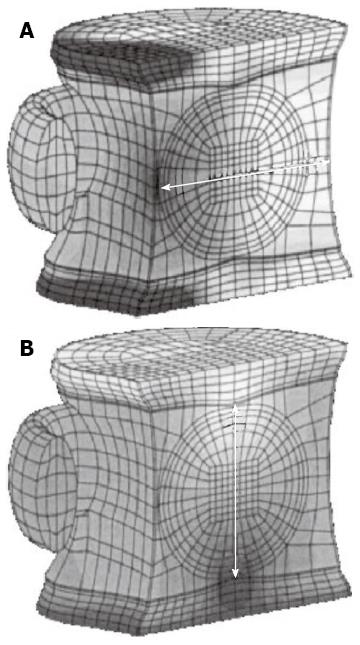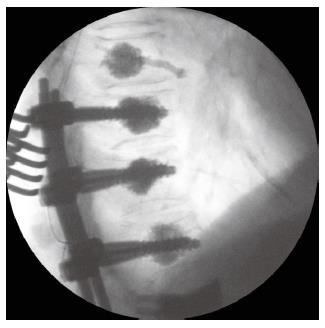Copyright
©2013 Baishideng Publishing Group Co.
World J Orthop. Oct 18, 2013; 4(4): 241-247
Published online Oct 18, 2013. doi: 10.5312/wjo.v4.i4.241
Published online Oct 18, 2013. doi: 10.5312/wjo.v4.i4.241
Figure 1 Wedge compression fracture of a lumbar vertebrae.
The lateral radiograph of the lumbar spine with an arrow demonstrating an osteoporotic compression fracture of the L2 vertebral body with significant collapse, in an elderly woman.
Figure 2 Three-dimensional quantitative computed tomography-based finite element modelling of the vertebral body.
The L3 vertebra from two individuals (one aged 70 and the second 64 years) modelled using voxels from 3D quantitative computed tomography, allowing estimation of bone mineral density. The model has been used to predict vertebral strength under axial compression, as illustrated by the colour scale. Overall vertebral strength were predicted as 4656 N in the younger patient (64 years) vs 6095 N in the older patient (70 years). Reproduced from Melton et al[5].
Figure 3 Pathological fracture of a lumbar vertebra.
Sagittal magnetic resonance imaging image displaying a pathological fracture of L1 vertebral body with collapse, secondary to metastatic infiltration (shown by arrow). The T12 vertebra also has metastatic deposits but is not fractured.
Figure 4 Finite element model of a metastatically-involved spinal motion segment.
A: Vertebral ‘‘bulge’’ in the transverse plane determines the risk of burst fracture independent of endplate failure; B: Axial vertebral displacement denotes risk of endplate failure resulting in burst fracture. Reproduced from Whyne et al[7].
Figure 5 Vertebroplasty and stabilization surgery of lumbar spine.
Intra-operative image intensifier lateral radiograph of the lumbar spine during vertebroplasty and posterior spinal instrumentation for osteoporotic compression fractures. polymethylmethacrylate bone cement is seen in the vertebral body and has been used to augment vertebral strength.
- Citation: Sisodia GB. Methods of predicting vertebral body fractures of the lumbar spine. World J Orthop 2013; 4(4): 241-247
- URL: https://www.wjgnet.com/2218-5836/full/v4/i4/241.htm
- DOI: https://dx.doi.org/10.5312/wjo.v4.i4.241













